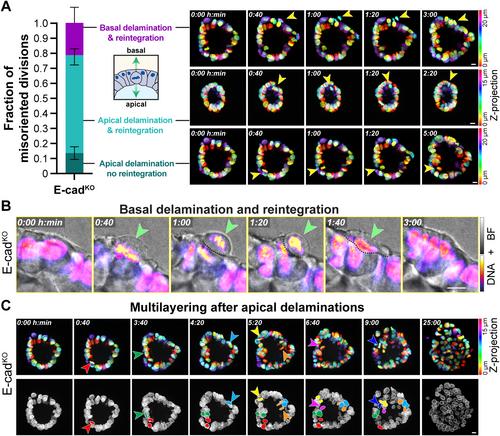Jooske L Monster, Lars JS Kemp, Georg A Busslinger, Marjolein J Vliem, Lucca LM Derks, Annelot AL Staes, Tanya M Bisseling, Hans Clevers, Rachel S van der Post, Martijn Gloerich
下载PDF
{"title":"Cell division-dependent dissemination following E-cadherin loss underlies initiation of diffuse-type gastric cancer","authors":"Jooske L Monster, Lars JS Kemp, Georg A Busslinger, Marjolein J Vliem, Lucca LM Derks, Annelot AL Staes, Tanya M Bisseling, Hans Clevers, Rachel S van der Post, Martijn Gloerich","doi":"10.1002/path.6277","DOIUrl":null,"url":null,"abstract":"<p>Loss of the cell–cell adhesion protein E-cadherin underlies the development of diffuse-type gastric cancer (DGC), which is characterized by the gradual accumulation of tumor cells originating from the gastric epithelium in the surrounding stroma. How E-cadherin deficiency drives DGC formation remains elusive. Therefore, we investigated the consequences of E-cadherin loss on gastric epithelial organization utilizing a human gastric organoid model and histological analyses of early-stage DGC lesions. E-cadherin depletion from gastric organoids recapitulates DGC initiation, with progressive loss of a single-layered architecture and detachment of individual cells. We found that E-cadherin deficiency in gastric epithelia does not lead to a general loss of epithelial cohesion but disrupts the spindle orientation machinery. This leads to a loss of planar cell division orientation and, consequently, daughter cells are positioned outside of the gastric epithelial layer. Although basally delaminated cells fail to detach and instead reintegrate into the epithelium, apically mispositioned daughter cells can trigger the gradual loss of the single-layered epithelial architecture. This impaired architecture hampers reintegration of mispositioned daughter cells and enables basally delaminated cells to disseminate into the surrounding matrix. Taken together, our findings describe how E-cadherin deficiency disrupts gastric epithelial architecture through displacement of dividing cells and provide new insights in the onset of DGC. © 2024 The Authors. <i>The Journal of Pathology</i> published by John Wiley & Sons Ltd on behalf of The Pathological Society of Great Britain and Ireland.</p>","PeriodicalId":232,"journal":{"name":"The Journal of Pathology","volume":"263 2","pages":"226-241"},"PeriodicalIF":5.6000,"publicationDate":"2024-04-04","publicationTypes":"Journal Article","fieldsOfStudy":null,"isOpenAccess":false,"openAccessPdf":"https://onlinelibrary.wiley.com/doi/epdf/10.1002/path.6277","citationCount":"0","resultStr":null,"platform":"Semanticscholar","paperid":null,"PeriodicalName":"The Journal of Pathology","FirstCategoryId":"3","ListUrlMain":"https://onlinelibrary.wiley.com/doi/10.1002/path.6277","RegionNum":2,"RegionCategory":"医学","ArticlePicture":[],"TitleCN":null,"AbstractTextCN":null,"PMCID":null,"EPubDate":"","PubModel":"","JCR":"Q1","JCRName":"ONCOLOGY","Score":null,"Total":0}
引用次数: 0
引用
批量引用
Abstract
Loss of the cell–cell adhesion protein E-cadherin underlies the development of diffuse-type gastric cancer (DGC), which is characterized by the gradual accumulation of tumor cells originating from the gastric epithelium in the surrounding stroma. How E-cadherin deficiency drives DGC formation remains elusive. Therefore, we investigated the consequences of E-cadherin loss on gastric epithelial organization utilizing a human gastric organoid model and histological analyses of early-stage DGC lesions. E-cadherin depletion from gastric organoids recapitulates DGC initiation, with progressive loss of a single-layered architecture and detachment of individual cells. We found that E-cadherin deficiency in gastric epithelia does not lead to a general loss of epithelial cohesion but disrupts the spindle orientation machinery. This leads to a loss of planar cell division orientation and, consequently, daughter cells are positioned outside of the gastric epithelial layer. Although basally delaminated cells fail to detach and instead reintegrate into the epithelium, apically mispositioned daughter cells can trigger the gradual loss of the single-layered epithelial architecture. This impaired architecture hampers reintegration of mispositioned daughter cells and enables basally delaminated cells to disseminate into the surrounding matrix. Taken together, our findings describe how E-cadherin deficiency disrupts gastric epithelial architecture through displacement of dividing cells and provide new insights in the onset of DGC. © 2024 The Authors. The Journal of Pathology published by John Wiley & Sons Ltd on behalf of The Pathological Society of Great Britain and Ireland.
E-cadherin缺失后细胞分裂依赖性扩散是扩散型胃癌发病的基础
扩散型胃癌(DGC)的特点是源自胃上皮的肿瘤细胞在周围基质中逐渐聚集。E-cadherin缺乏是如何导致DGC形成的,目前仍不清楚。因此,我们利用人体胃器官模型和早期DGC病变的组织学分析,研究了E-cadherin缺失对胃上皮组织的影响。胃有机体中E-cadherin的缺失再现了DGC的启动过程,单层结构逐渐丧失,单个细胞脱落。我们发现,胃上皮细胞中E-cadherin的缺乏不会导致上皮凝聚力的普遍丧失,但会破坏纺锤体定向机制。这导致细胞平面分裂定向的丧失,从而使子细胞位于胃上皮细胞层之外。虽然基底分层细胞无法脱离,而是重新整合到上皮中,但顶端错位的子细胞会导致单层上皮结构逐渐丧失。这种受损的结构阻碍了定位错误的子细胞重新整合,并使基底脱层细胞扩散到周围基质中。综上所述,我们的研究结果描述了 E-cadherin 缺乏如何通过分裂细胞的移位破坏胃上皮结构,并为 DGC 的发病提供了新的见解。© 2024 作者。病理学杂志》由 John Wiley & Sons Ltd 代表大不列颠及爱尔兰病理学会出版。
本文章由计算机程序翻译,如有差异,请以英文原文为准。


 求助内容:
求助内容: 应助结果提醒方式:
应助结果提醒方式:


